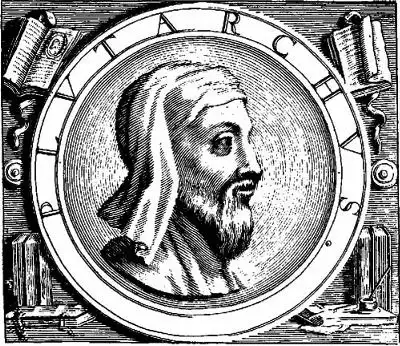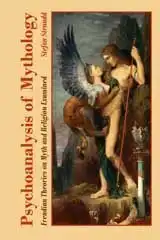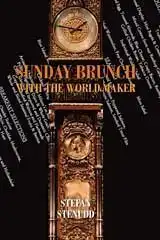Plutarch: Battle of Daemons Theories through History about Myth and Fable 6
Plutarch (c. 46-120) was a Greek historian whose most famous work is Parallel Lives, where he compared the biographies of distinguished Greeks and Romans. His thoughts are not that very different from those presented above and those following below, in so much as he propagated reading the myths as something more than the absurd adventure stories they may seem to be: "you must not think that any of these tales actually happened in the manner in which they are related." [Plutarch, 'Isis and Osiris', Moralia, vol. V, translated by Frank Cole Babbitt, London 1936, 29.] Plutarch was convinced, like most of the later writers on the subject, that the myths conveyed other meanings of religious and ritualistic kind. Where later Christian mythologists concentrated on the Greek fables, Plutarch turned to the Egyptians, as did many Greeks when searching for the ancient sources to their own mythology. To Plutarch, a myth like that of Isis and Osiris and their tragic struggle against their foe Typhon should be understood as telling something profound about nature and the powers ruling it: Just as the rainbow, according to the account of the mathematicians, is a reflection of the sun, and owes its many hues to the withdrawal of our gaze from the sun and our fixing it on the cloud, so the somewhat fanciful accounts here set down are but reflections of some true tale which turns back our thoughts to other matters. [Plutarch 1936, 51.] Plutarch claims to have support from Egyptian traditions in reading the myth as a symbolic account of the drama of natural forces: And thus among the Egyptians such men say that Osiris is the Nile consorting with the Earth, which is Isis, and that the sea is Typhon into which the Nile discharges its waters and is lost to view and dissipated, save for that part which the earth takes up and absorbs and thereby becomes fertilized. [Plutarch 1936, 77ff.] But he goes on. To Plutarch, the myth's symbolic content is one of higher and more general principles, understood by the Egyptian priestly elite. So, Isis is the earth, which is a basic and complete natural force of its own, and in this capacity as that out of which everything grows she is "the female principle of Nature." [Plutarch 1936, 129.] As for the other two players in the drama: The wiser of the priests call not only the Nile Osiris and the sea Typhon, but they simply give the name of Osiris to the whole source and faculty creative of moisture, believing this to be the cause of generation and the substance of life-producing seed; and the name of Typhon they give to all that is dry, fiery, and arid, in general, and antagonistic to moisture. [Plutarch 1936, 81.] Then the battle between Isis and Osiris versus Typhon is one of moisture: The earth needs moisture to be fertile, whereas drought leads to decay. This comes quite close to the cyclic shift of the seasons and thereby to such theories about myths as the one presented by James G. Frazer some 1800 years later in his book The Golden Bough. But Plutarch would have none of that: We shall undertake to deal with the numerous and tiresome people, whether they be such as take pleasure in associating theological problems with the seasonal changes in the surrounding atmosphere, or with the growth of the crops and seed-times and ploughing; and also those who say that Osiris is being buried at the time when the grain is sown and covered in the earth and that he comes to life and reappears when plants begin to sprout. [Plutarch 1936, 153.] To Plutarch, such a view leads to atheism, which he deplores, by "conferring the names of gods upon natural objects which are senseless and inanimate." [Plutarch 1936, 155.] Although he connects the three figures of the myth to natural forces, this does not mean he robs them of personal will and identity. He will not have them dethroned from deity: "God is not senseless nor inanimate nor subject to human control." Isis, Osiris, and Typhon actively control the natural forces to which they are connected. So, the myth about the battle between them is in this way accurate, albeit misunderstood if believed to be only a senseless war of deities over nothing at all. The three may not be full-feathered gods, though, since Plutarch regards that title really to belong only to one supreme being, referring to Zeus: "Him who is the First, the Lord of All, the Ideal One." [Plutarch 1936, 9.] Taking support from Plato, Pythagoras, Xenocrates, Chrysippus, and Homer, he classifies figures such as the three of this myth as demigods or daemons. Daemon, Latin from the Greek daimon, is a kind of deity that — contrary to the modern concept of demons — can be benevolent as well as malevolent. According to Plutarch they are: stronger than men and, in their might, greatly surpassing our nature, yet not possessing the divine quality unmixed and uncontaminated, but with a share also in the nature of the soul and in the perceptive faculties of the body, and with a susceptibility to pleasure and pain and to whatsoever other experience is incident to these mutations, and is the source of much disquiet in some and of less in others. [Plutarch 1936, 59ff.] They cannot be complete gods since in them, as in men, there are diverse "degrees of virtue and vice." He refers to Plato's Symposium when describing these half-gods as: an interpretative and ministering class, midway between gods and men, in that they convey thither the prayers and petitions of men, and thence they bring hither the oracles and the gifts of good things. [Plutarch 1936, 65.] Plutarch goes on to explain that the real distinction between deities is one between good and bad. Nature does by necessity contain both: For if it is the law of nature that nothing comes into being without a cause, and if the good cannot provide a cause for evil, then it follows that Nature must have in herself the source and origin of evil, just as she contains the source and origin of good. [Plutarch 1936, 111.] He sees the world as a grand battlefield between good and evil, better or bad, where the former has some predominance. Still, not enough so that the battle comes to an end: Yet it is impossible for the bad to be completely eradicated, since it is innate, in large amount, in the body and likewise in the soul of the Universe, and is always fighting a hard fight against the better. [Plutarch 1936, 121.] This very profound conflict within nature makes Plutarch conclude that there are really but two deities: The great majority and the wisest of men hold this opinion: they believe that there are two gods, rivals as it were, the one the Artificer of good and the other of evil. There are also those who call the better one a god and the other a daemon. [Plutarch 1936, 111.] So, the battle of Isis and Osiris versus Typhon is, as any battle in nature, one between good and evil. Therefore it cannot end, but repeats itself over and over. In his discussion of how to understand mythology, Plutarch expresses outright contempt for the theory of Euhemerus in the early 3rd century BC, who claimed that many of the myths refer to historical persons and events, having been enhanced and glorified by posterity. Plutarch calls Euhemerus deceitful and many of the myths he used to prove his thesis non-existent. What enrages Plutarch the most is that Euhemerus promoted atheism: by obliterating the gods of our belief and converting them all alike into names of generals, admirals, and kings, who, forsooth, lived in very ancient times and are recorded in inscriptions written in golden letters at Panchon, which no foreigner and no Greek had ever happened to meet with, save only Euhemerus. He, it seems, made a voyage to the Panchoans and Triphyllians, who never existed anywhere on earth and do not exist! [Plutarch 1936, 57.] Nevertheless, the theory of Euhemerus, to which I will return, made a lasting impression way beyond the days of Plutarch. That can be seen in the thoughts of several others presented above. It is still around in one or other form. And Plutarch was himself not beyond errors. He assumes a connection between Egyptian gods as well as words and Greek ones, even claiming the latter to be the roots. On the other hand, he is in good company with both Plato and Herodotus making such assumptions. [Plutarch 1936, 4.] Later mythologists would also frequently fall into the trap of making dubious language connections.
NEXTEuhemerus: Myth as Actual History.
Mythology Meanings Menu
MENUCreation Myths Around the WorldHow stories of the beginning began.
The Meanings of MythologyTheories through history about myth and fable.
Archetypes in MythsThe mythological symbols and what they stand for.
The Logics of MythPatterns of creation.
ContactAbout Cookies
CREATION MYTHS IN DEPTHCreation in Rig Veda 10:129The paradox of origin, according to an Indian myth.
Genesis 1The first creation story of the bible scrutinized.
Enuma ElishThe ancient Babylonian creation myth.
Xingu Creation of ManThe insoluble solitude of gods and humans.
ON MY OTHER WEBSITESPsychoanalysis of MythWhat Sigmund Freud and C. G. Jung thought about myths, their origins and meanings.
Myth of CreationAn introduction to the subject of creation myths and the patterns of thought they reveal.
Cosmos of the AncientsWhat the Greek philosophers believed about the cosmos, their religion and their gods.
Life EnergyThe many ancient and modern life force beliefs all over the world explained and compared.
TaoisticTaoism, the ancient Chinese philosophy of life explained. Also, the complete classic text Tao Te Ching online.
|
 Archetypes of Mythology
Archetypes of Mythology Psychoanalysis of Mythology
Psychoanalysis of Mythology Cosmos of the Ancients
Cosmos of the Ancients Life Energy Encyclopedia
Life Energy Encyclopedia Sunday Brunch with the World Maker
Sunday Brunch with the World Maker Fake Lao Tzu Quotes
Fake Lao Tzu Quotes Stefan Stenudd
Stefan Stenudd